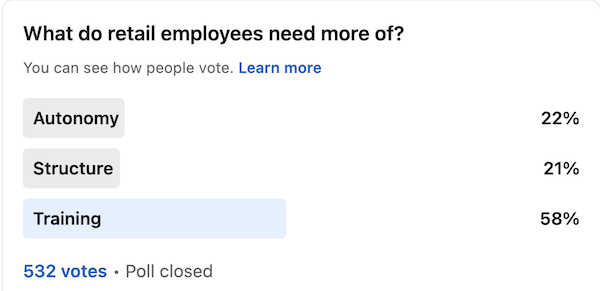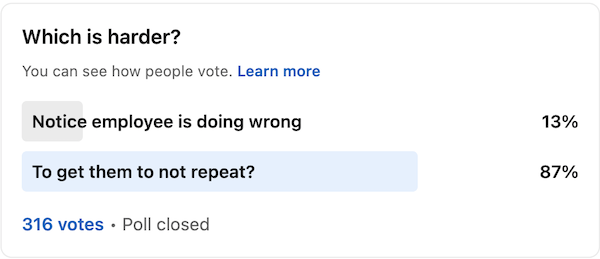Updated June 4, 2024
Effective sales training is crucial for success in today's fast-paced retail environment. Training has never been more critical as shoppers pause and rethink purchases they would have impulsively made just a few years ago.
Many retailers have cut back on the easiest way to get more from their sales floor—training their employees to sell the merchandise. Often, this is a one-and-done process completed hastily during onboarding.
That showed up in a poll I took on LinkedIn, where 58% said they knew employees needed more training.

Training content is quickly forgotten or not retained by sales personnel, wasting time, effort, and resources. Another poll showed that it is hard to get associates to refrain from repeating sales-busting behaviors.

This happens because trainers try to fill trainees' heads with too much information, the skills are not practiced, and the learners don't get enough support to remember what they learned. That leads to higher turnover and fewer long-term employees.
To solve this problem and ensure your sales team remembers and uses what they learned during training, I've put together ten clever methods to help them remember better and lead to long-term success.
Here's how to change how you teach your sales team and help them become the best they can be.
- Break down content into focused key topics: Split the training into smaller, easier-to-learn units that build upon each other. This helps make it simpler to understand and remember. You want them to find value in lesson one, not wait for results.
- Make training an ongoing event: Regular interactive training and review sessions keep store associates updated. Training can not be a once-and-done checkbox if you want to hold onto employees. They don't want to wait around for someone to come in and ask a question or for them to be given a task. They want to grow and keep their brains engaged.
- Emphasize role-playing and practice: Encourage your team to engage in role-playing exercises, mock scenarios, and real-life sales situations to enhance their skills and confidence. Practicing away from customers ensures associates understand and can prove they know what to do. If, after that role-play scenario, any deviation from what was trained becomes a will issue, not a skill issue.
- Utilize different learning styles: Cater to visual, auditory, and kinesthetic learners by offering a variety of presentation types and formats, such as classroom learning, online courses, and in-person classes. A study by Muneera Spence found that visual learners account for around 30% of the population, auditory learners account for around 25%, and kinesthetic learners may account for as much as 45%.
- Employ gamified learning management systems (LMS): Incorporate gamification elements into your LMS to make the training process engaging and enjoyable. Things like leaderboards and badges give younger learners the sense of accomplishment they get from gaming.
- Encourage peer coaching and mentoring: Incentivize top-performing salespeople to share their expertise and experiences with the rest of the team, fostering a culture of continuous learning and growth. An excellent way to do this is to make short 3-5 minute videos of their tribal knowledge about products. Add text and testing to ensure it becomes part of your regular customer experience.
- Implement follow-up assignments with incentives: Assign specific tasks and goals to sales personnel after the training, with appropriate rewards for successful implementation. But make sure you incentivize the doing of your training, not completion. You might even have a retention bonus six or twelve months after training. Knowing doesn't equal doing.
- Establish leadership buy-in and reinforcement: Ensure leadership supports the training initiatives from the beginning. Why are we doing this? What are the expected outcomes? What has to change in scheduling and managing? All of these should be decided at the highest level to gain acceptance as part of your Retail Management. Then, the learned material must be consistently discussed and reinforced during sales meetings and one-on-one sessions.
- Maximize memory consolidation: Highlight the importance of good sleep and regular review sessions to strengthen memory retention. A little learning every day, then a quick session to reflect and remember the next is most effective.
- Practice, practice, practice: Encourage your sales team to immediately apply the training content in their daily work, offering support and coaching, mainly as they try new ways to greet customers, explain benefits, and follow up. Mentoring makes new skills "stick."
In Sum
If you want your sales team to do great in stores today, you need to teach them in a way that's easy for them to understand and remember. You can do this by breaking lessons into smaller parts, keeping lessons going all the time, and using different teaching methods like videos and hands-on activities.
Make learning fun with games, have the best salespeople teach others, and reward them for using what they learn. The bosses must show they care about the training from the outset and help the team remember what they learn.
Most of all, have your sales team practice a lot so they get good at their jobs. After all, retail is a game of being brilliant on the basics and repetition.
These ten clever techniques will help your sales team become the best they can be, and your store will do better, too.
Want them to do even better? Check out my online retail sales training program, SalesRX, which helps you do all this and is a proven system used on four continents to drive sales.

-1.webp?width=760&height=395&name=customers-shopping-in-modern-clothing-store-retail-sales-associate-assists-client-diverse.jpg_s=1024x1024%26w=is%26k=20%26c=H__aeG0-_BL_tOo-RblQJghajykXRn2reeVkEBhAhsw=%20(1)-1.webp)
-1.webp?width=760&height=395&name=customers-shopping-in-modern-clothing-store-retail-sales-associate-assists-client-diverse.jpg_s=1024x1024%26w=is%26k=20%26c=H__aeG0-_BL_tOo-RblQJghajykXRn2reeVkEBhAhsw=%20(1)-1.webp)